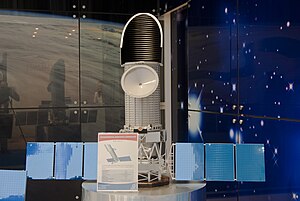


Model of WSO-UV telescope during "Space Week" in Madrid, May 2011
| |
| Mission type | Space telescope |
|---|---|
| Operator | Russian Astro Space Center |
| Spacecraft properties | |
| Manufacturer | NPO Lavochkin |
| Payload mass | 2,840 kg (6,261 lb) |
| Start of mission | |
| Launch date | 2030 (proposed)[1] |
| Rocket | Angara A5M[2] |
| Launch site | Vostochny Site 1A |
| Contractor | Roscosmos |
| Main telescope | |
| Wavelengths | 115 to 315 nm |
Spektr program
Spektr-M →
| |
Spektr-UV, also known as World Space Observatory-Ultraviolet (WSO-UV), is a proposed ultraviolet space telescope intended for work in the 115 nm to 315 nm wavelength range.[3][4] It is an international project led by Russia (Roscosmos), with participation from Spain and Japan. The launch had initially been planned for 2007, but has since been continually delayed;[5] as of December 2023[update], the launch is expected to take place no earlier than 2030[1] atop an Angara A5M rocket from Vostochny Cosmodrome.[2]
The main instrument of the observatory is a 1.7-metre Ritchey–Chrétien telescope. The telescope will be equipped with the following instruments:
The WUVS spectrographs assembly consists of four channels:
The FCU has two channels, each fed by an independent pick off mirror:
This section needs expansion with: text. You can help by adding to it. (August 2019)
|
In October 2012, tests of antennas for the space telescope were completed.[8]
In July 2019, INASAN selected the first seven experiments to be performed by the observatory.[9]
Spektr-UV is an international project led by Russia (Roscosmos). At present the international cooperation includes three basic participants: Russia (will provide the telescope, spacecraft, launch facilities, ground segment); Spain (FCU detectors, ground segment); Japan (UVSPEX).
|
| |||||||||||||
|---|---|---|---|---|---|---|---|---|---|---|---|---|---|
| Operating |
| ||||||||||||
| Planned |
| ||||||||||||
| Proposed |
| ||||||||||||
| Retired |
| ||||||||||||
| Hibernating (Mission completed) |
| ||||||||||||
| Lost/Failed |
| ||||||||||||
| Cancelled |
| ||||||||||||
| Related |
| ||||||||||||
| |||||||||||||
|
Russian space observatories
| |
|---|---|
| Current |
|
| Past |
|
| Planned |
|
|
| |||||||||
|---|---|---|---|---|---|---|---|---|---|
| |||||||||
| Launch sites |
| ||||||||
| Launch vehicles |
| ||||||||
| Human spaceflight programs |
| ||||||||
| Robotic programs |
| ||||||||
| Communications |
| ||||||||
| Concepts |
| ||||||||
| Images and artwork |
| ||||||||
| Related |
| ||||||||
| |||||||||